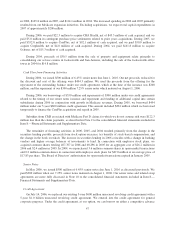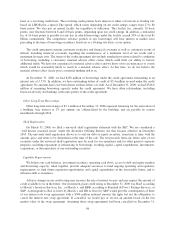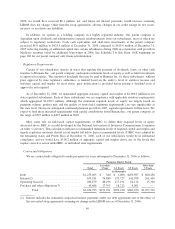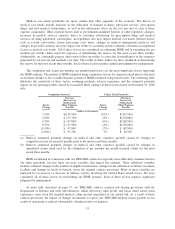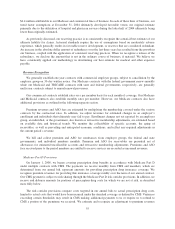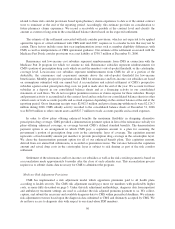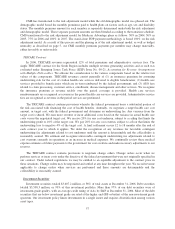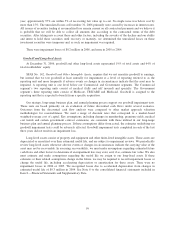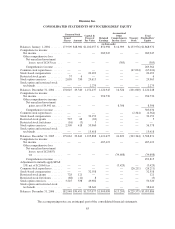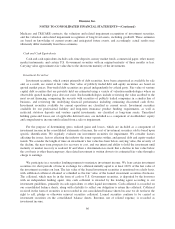Humana 2006 Annual Report Download - page 68
Download and view the complete annual report
Please find page 68 of the 2006 Humana annual report below. You can navigate through the pages in the report by either clicking on the pages listed below, or by using the keyword search tool below to find specific information within the annual report.related to these risk corridor provisions based upon pharmacy claims experience to date as if the annual contract
were to terminate at the end of the reporting period. Accordingly, this estimate provides no consideration to
future pharmacy claims experience. We record a receivable or payable at the contract level and classify the
amount as current or long-term in the consolidated balance sheets based on the expected settlement.
The estimate of the settlement associated with risk corridor provisions, which is not expected to be applied
against the rigors of a final settlement with CMS until mid-2007, requires us to consider factors that may not be
certain. These factors include some first year implementation issues such as member eligibility differences with
CMS, as well as interpretations of CMS operational guidance. Our estimate of the settlement associated with the
Medicare Part D risk corridor provisions was a net liability of $738.7 million at December 31, 2006.
Reinsurance and low-income cost subsidies represent reimbursements from CMS in connection with the
Medicare Part D program for which we assume no risk. Reinsurance subsidies represent reimbursements for
CMS’s portion of prescription drug costs which exceed the member’s out-of-pocket threshold, or the catastrophic
coverage level. Low-income cost subsidies represent reimbursements from CMS for all or a portion of the
deductible, the coinsurance and co-payment amounts above the out-of-pocket threshold for low-income
beneficiaries. Monthly prospective payments from CMS for reinsurance and low-income cost subsidies are based
on assumptions submitted with our annual bid. A reconciliation and related settlement of CMS’s prospective
subsidies against actual prescription drug costs we paid is made after the end of the year. We account for these
subsidies as a deposit in our consolidated balance sheets and as a financing activity in our consolidated
statements of cash flows. We do not recognize premium revenues or claims expense for these subsidies. Receipt
and payment activity is accumulated at the contract level and recorded in our consolidated balance sheets in other
current assets or trade accounts payable and accrued expenses depending on the contract balance at the end of the
reporting period. Gross financing receipts were $2,002.5 million and gross financing withdrawals were $2,124.7
million during 2006. CMS subsidy activity recorded to the consolidated balance sheets at December 31, 2006
was $450.0 million to other current assets and $327.7 million to trade accounts payable and accrued expenses.
In order to allow plans offering enhanced benefits the maximum flexibility in designing alternative
prescription drug coverage, CMS provided a demonstration payment option in lieu of the reinsurance subsidy for
plans offering enhanced coverage, or coverage beyond CMS’s defined standard benefits. The demonstration
payment option is an arrangement in which CMS pays a capitation amount to a plan for assuming the
government’s portion of prescription drug costs in the catastrophic layer of coverage. The capitation amount
represents a fixed monthly amount per member to provide prescription drug coverage in the catastrophic layer.
We chose the demonstration payment option for all of our enhanced benefit plans. This capitation amount,
derived from our annual bid submissions, is recorded as premium revenue. The variance between the capitation
amount and actual drug costs in the catastrophic layer is subject to risk sharing as part of the risk corridor
settlement.
Settlement of the reinsurance and low-income cost subsidies as well as the risk corridor payment is based on
a reconciliation made approximately 6 months after the close of each calendar year. This reconciliation process
requires us to submit claims data necessary for CMS to administer the program.
Medicare Risk Adjustment Provisions
CMS has implemented a risk adjustment model which apportions premiums paid to all health plans
according to health severity. The CMS risk adjustment model pays more for members with predictably higher
costs, as more fully described on page 5. Under this risk adjustment methodology, diagnosis data from inpatient
and ambulatory treatment settings are used to calculate the risk adjusted premium payment to us. We collect,
capture, and submit the necessary and available diagnosis data to CMS within prescribed deadlines. We estimate
risk adjustment revenues based upon the diagnosis data submitted to CMS and ultimately accepted by CMS. We
do not have access to diagnosis data with respect to our stand-alone PDP members.
56



